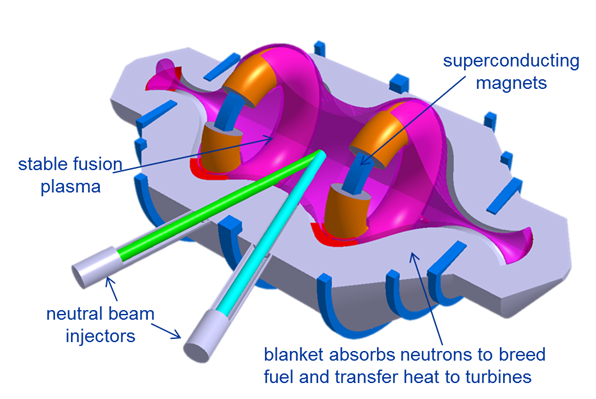
18th October 2014 Lockheed Martin planning a compact fusion reactor within 10 years This week, Lockheed Martin announced plans for a small-scale fusion power plant to be developed in as little as 10 years. A number of experts have expressed doubts over its viability.
If it ever became a reality, fusion power would be truly world-altering – a clean, safe and essentially limitless supply of energy allowing humanity's continued survival for centuries and millennia to come. The international project known as ITER is planned for operation in 2022 and its eventual successor may emerge in the 2040s. Widespread deployment of fusion is not expected until 2070. U.S. defence giant Lockheed Martin hopes to accelerate progress in this area, by developing what it calls a compact fusion reactor (CFR). This would be around 10 times smaller than conventional tokamak designs, small enough to fit on the back of a truck and generating 100 megawatts (MW) of power. The company intends to build a prototype within five years – according to its press release – with commercial introduction five years after that. It has several patents pending for the work and is looking for partners in academia, industry and among government laboratories. As illustrated above, the main improvement over ITER would be the use of a superconducting torus to create a differently shaped magnetic field, able to contain plasma far better than previous configurations. These small reactors could be fitted in U.S. Navy warships and submarines while eliminating the need for other fuel types. They could power small cities of up to 100,000 people, allow planes to fly with unlimited range, or even be used in spacecraft to cut journey times to Mars from six months to a single month. Using a CFR, the cost of desalinated water could fall by 60 percent.
If this sounds too good to be true, it may well be. Although Lockheed has been successful in its magnetised ion confinement experiments, a number of significant challenges remain for a working prototype with plasma confinement – let alone a commercialised version. "I think it's very overplayed," University of California nuclear engineering professor Dr. Edward Morse told The Register. "They are being very cagey about divulging details." "Getting net energy from fusion is such a goddamn difficult undertaking," said University of Texas physicist Dr. Swadesh M. Mahajan, in an interview with Mother Jones. "We know of no materials that would be able to handle anywhere near that amount of heat." "The nuclear engineering clearly fails to be cost effective," Tom Jarboe told Business Insider in an email. For these reasons, it is perhaps best to wait for more news and developments before adding the CFR to our timeline. We will, of course, keep you updated on Lockheed's progress as it emerges. You can also discuss this project on our forum.
Comments »
|







